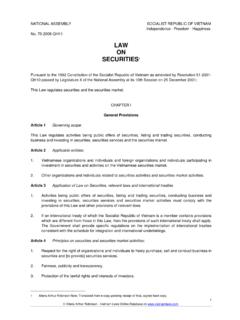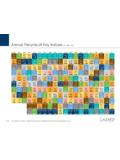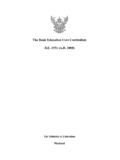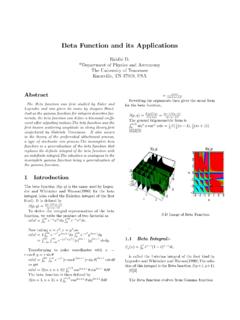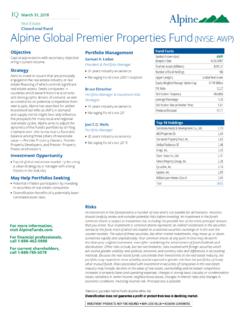Transcription of OECD Services Trade Restrictiveness Index: Policy trends ...
1 OECD Services Trade Restrictiveness Index: Policy trends up to 2018 January 2018 OECD Trade AND AGRICULTURE DIRECTORATE This booklet is published under the responsibility of the Secretary-General of the OECD. The opinions expressed and the arguments employed herein do not necessarily reflect the official views of OECD countries. The publication of this booklet has been authorised by Ken Ash, Director of the Trade and Agriculture Directorate Comments are welcome and should be sent to Photo credits.
2 Cover Illustration Jeffrey Fisher OECD (2018) You can copy, download or print OECD content for your own use, and you can include excerpts from OECD publications, databases and multimedia products in your own documents, presentations, blogs, websites and teaching materials, provided that suitable acknowledgment of OECD as source and copyright owner is given. All requests for commercial use and translation rights should be submitted to OECD 2018 STRI Policy trends up to 2018 The OECD Services Trade Restrictiveness index (STRI) is a unique tool that provides up-to-date information on regulatory changes that affect Trade in Services in 44 countries across 22 sectors, accounting for over 80% of global Services Trade .
3 Launched in 2014 and updated annually, the STRI offers a comprehensive and transparent overview of global trends in Services Trade regulations, while facilitating deeper analysis into the effects that such regulations have on Trade in Services . The STRI is updated each year to incorporate changes that have been introduced through new or amended laws and regulations. This evidence-based tool allows policymakers to assess reform options, benchmark them relative to global best practice, and assess their likely impact; helps Trade negotiators identify restrictions that most impede Trade ; and is a source of regulatory transparency for businesses seeking to enter foreign markets.
4 Results from the most recent STRI update show that although there is evidence of some progressive liberalisation of Services markets, the overall 2017 STRI indices are more restrictive than in 2016, highlighting an overall tightening of the global regulatory environment for Services Trade . These results are largely due to restrictive horizontal Policy changes being implemented in a number of countries that affect all Services sectors. This was particularly the case for measures affecting Services supplied through the temporary movement of natural persons (Mode 4), due to more stringent entry conditions being applied to persons seeking to provide Services on a temporary basis, such as intra-corporate transferees, contractual or independent Services suppliers.
5 In addition, some countries have introduced economy-wide limitations on cross-border data flows. Top regulatory performers The top ten countries with the most open markets for Services Trade in 2017 are Latvia,Ireland, Germany, Netherlands, Australia, Lithuania, Denmark, Japan, United Kingdom,and the Czech Republic. Norway recorded the most significant liberalising reforms in 2017, followed by Indonesiaand Iceland. Leading sectoral reformers from 2014 to 2017 include Mexico in telecommunications, thePeople s Republic of China in rail freight transport Services , and Japan in logistics Services (customs brokerage).
6 Top Services exporters The United States exported Services worth USD 752 billion in 2016, followed by theUnited Kingdom (USD 333 billion), Germany (USD 281 billion), France (USD 237 billion),and the People s Republic of China (USD 207 billion).4 STRI Policy trends UP TO 2018 OECD 2018 Key analytical findings Services Trade barriers impede Services exports. OECD estimates reveal that thetrade cost equivalent of Services Trade barriers largely exceeds the average tariff ontraded goods.
7 Services Trade barriers have a strong anti-export bias that impedesservices exports as much as Services imports. Trade costs arise both from policies thatexplicitly target foreign suppliers and from domestic regulation that falls short of bestpractice in the area of competition Policy and rule-making. Consumers and firms pay the cost of Trade restrictions. Entry barriers allowincumbent firms to gain market power, limit competition, and delay innovation. Thecosts of a Policy environment that reduces competition from new entrants, whetherdomestic or foreign, is ultimately borne by consumers and downstream businesscustomers, who pay higher prices and enjoy less choice than they would in morecompetitive markets.
8 The resulting price increases for domestic users of Services canbe quantified as a sales tax equivalent on their purchases. On average, estimates of thetax equivalent of the restrictions recorded in the STRI range from about 3% in roadfreight transport to almost 40% in broadcasting. In some segments of transport andlogistics, as well as in construction, the average estimated sales tax equivalent is about20%, and in some countries almost 80%, imposing substantial additional costs onmanufacturing enterprises and eventually on final customers.
9 Regulatory co-operation can reduce Trade costs. Differences among countries inregulating the same service create additional costs for exporters that need to adapt tonew sets of rules in each new market. Regulatory differences become more importantas Trade barriers come down to a level where firms start to consider entering multiplemarkets. Thus, when markets are relatively open, Trade costs imposed by the averagedegree of regulatory differences is estimated at about 40% in ad valorem terms. Whileregulatory harmonisation can reduce Trade costs, removing the most onerousrestrictions first is a prerequisite to maximise the gains from regulatory co-operation.
10 Trade in Services depends on the movement of professionals. The cross-bordermovement of people does not account for a large share of Services Trade , but it isessential for international business operations. Mobility of natural persons acrossinternational borders is particularly key for Trade in business Services , which in turnis an important channel for knowledge transfer. Trade in Services underpins the digital economy. Liberalisation and pro-competitive reforms in the telecommunications sector are associated with asubstantial reduction in the Trade costs for business Services .










